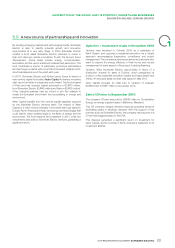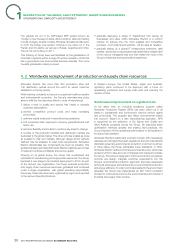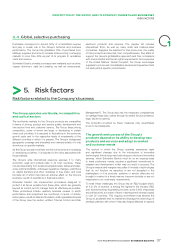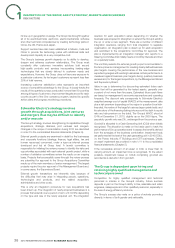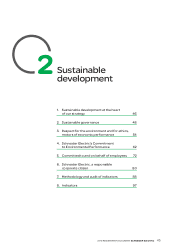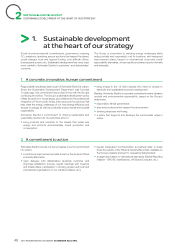APC 2010 Annual Report Download - page 38
Download and view the complete annual report
Please find page 38 of the 2010 APC annual report below. You can navigate through the pages in the report by either clicking on the pages listed below, or by using the keyword search tool below to find specific information within the annual report.
DESCRIPTION OFTHEGROUP, ANDITSSTRATEGY, MARKETS ANDBUSINESSES
1ORGANISATIONAL SIMPLICITY ANDEFFICIENCY
The gradual roll out of an SAP-based ERP system known as
“bridge” is now focused on back-offi ce functions. After pilot testing
in India, Hungary, Austria, Croatia, Romania, Slovakia and Slovenia,
in 2010 the bridge core system continue to be rolled out in the
French and US plants, as well as in Russia, Argentina and Chile.
The roll out will continue in 2011.
This thinking at Group level was facilitated by the globalisation of
information systems within a single IT function created in 2009 that
has a governance role and provides services internally. This move
towards globalisation mainly involved:
•gradually deploying a single IT Department that serves all
businesses and users within Schneider Electric in a uniform
manner. To achieve this, the most qualifi ed and competitive
providers – both internal and external – will be used as needed;
•gradually setting up a global IT infrastructure (networks, data
centres, distributed computing and help desk) that is independent
of the various managerial lines and that makes the most of the
Group’s critical size and accumulated experience.
4. 3 Worldwide redeployment of production and supply chain resources
Schneider Electric has more than 200 production sites and
140 distribution centres around the world for whom customer
satisfaction is the top priority.
While working constantly to improve occupational health and safety
and environmental protection, the Group’s manufacturing policy
aims to fulfi ll fi ve key objectives (listed in order of importance):
1. deliver a level of quality and service that meets or exceeds
customer expectations;
2. achieve competitive product costs and keep increasing
productivity;
3. optimise capital employed in manufacturing operations;
4. limit production sites’ exposure to currency, geopolitical and cost
factor risk;
5. enhance fl exibility and be able to continuously adapt to change.
A number of the production facilities and distribution centres are
dedicated to the global market. The other units are located as close
as possible to their end markets. Although design and/or esthetic
features may be adapted to meet local requirements, Schneider
Electric standardises key components as much as possible. This
global/local approach helps Schneider Electric maximise economies
of scale and optimise profi tability and service quality.
Drawing on its global scope, the Group has re-balanced and
optimised its manufacturing and supply chain resources. The Group
launched a new stage in its industrial deployment in 2010. As part
of the Group’s new organisation, the Power business production
and supply chain resources have been globalised and combined
under a single organisation, with global operating responsibility.
Previously, these resources were organised by region and reported
to the various Operating Divisions.
In Western Europe, the United States, Japan and Australia,
rightsizing plans continued to be deployed with a focus on
specialising production and supply chain units and reducing the
number of sites.
Continuous improvement on a global scale
At the same time, an industrial excellence program called
Schneider Production System (SPS) has been rolled out in all
plants to substantially and continuously improve service quality
and productivity. The program also takes environmental criteria
into account. Based on a lean manufacturing approach, SPS
is supported by the extension of Six Sigma and Quality and
Value Analysis programs across the Group. By deploying these
optimisation methods globally and sharing best practices, the
Group intends to lift the operational performance of all its plants to
the same high standard.
Schneider Electric’s plants and products comply with increasingly
extensive and stringent European regulations and with international
standards governing environmental protection in all host countries.
In many cases, the Group anticipates future standards. In 1992,
Schneider Electric defi ned a formal environmental policy, which was
revised in 2004 to take account of changes both inside and outside
the Group. This policy is designed to improve production processes,
promote eco-design, integrate customer expectations into the
Group’s environmental protection approach and raise awareness
among all employees and partners about environmental protection
and energy effi ciency. In order to limit risks related to the environment
generally, the Group has implemented an ISO 14001-compliant
process to continuously improve the environmental performance of
its plants and supply chain centres.
2010 REGISTRATION DOCUMENT SCHNEIDER ELECTRIC36









